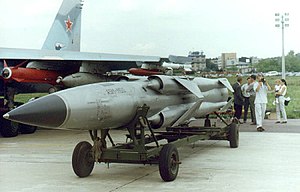P-270 Moskit
| Moskit | |
|---|---|

Moskit missile at MAKS, Zhukovskiy, 1999. Note that the fins are folded for storage. When deployed, they protrude at 90 degrees from the missile centerline.
|
|
| Type | Anti-ship missile |
| Place of origin | Soviet Union |
| Service history | |
| In service | 1984, the first ship with 3M80 missiles was actually ready in 1978, formally adopted in 1981 |
| Used by | Soviet Union, Russia, China, Egypt |
| Production history | |
| Manufacturer | MKB Raduga |
| Produced | 1983 |
| Specifications | |
| Weight | 4,500 kg (9,900 lb) |
| Length | 9.745 m (31.97 ft) |
| Diameter | 0.8 m (2.6 ft) |
| Warhead | 320 kg (710 lb) explosive or 120 kt of TNT fission-fusion thermonuclear |
|
|
|
| Engine | Four ramjets (solid fuel rocket on air-to-surface version) |
| Wingspan | 2.10 m (6.9 ft) |
|
Operational
range |
120–250 km (75–155 mi) |
| Flight altitude | 20 m (66 ft) above sea level |
| Speed | Mach 3 |
|
Guidance
system |
inertial guidance plus terminal active radar homing |
|
Launch
platform |
naval ships, fixed-wing aircraft , coastal and road mobile TEL |
The P-270 Moskit (Russian: П-270 «Москит»; English: Mosquito) is a Russian supersonic ramjet powered Anti-Ship missile. Its GRAU designation is 3M80, air launched variant is the Kh-41 and its NATO reporting name is SS-N-22 Sunburn. The missile system was designed by the Raduga Design Bureau during the 1970s as a follow up to the "SS-N-9 Siren". The Moskit was originally designed to be ship-launched, but variants have been adapted to be launched from land (modified trucks), underwater (submarines) and air (reportedly the Sukhoi Su-33, a naval variant of the Sukhoi Su-27), as well as on the Lun-class ekranoplan. The missile can carry conventional and nuclear warheads. The exact classification of the missile is unknown, with varying types reported. This uncertainty is due to the secrecy surrounding an active military weapon. The Moskit is one of the missiles known by the NATO codename SS-N-22 Sunburn.
The missile has been purchased and exported to the People's Liberation Army Navy (China) and Indian Navy (India).
It reaches a speed of Mach 3 at high altitude and Mach 2.2 at low-altitude. This speed is 4.25 to 3 times more than speed of the subsonic American Harpoon. When slower missiles, like the Harpoon or the French Exocet are used, the maximum theoretical response time for the defending ship is 120 to 150 seconds. This long response time provides time to launch countermeasures and employ jamming before deploying "hard" defense systems such as missiles and close-in weapon systems. But the high speed of the 3M82 "Mosquito" missiles reduce the maximum theoretical response time for the defending ship to 25 to 30 seconds. This short response time makes jamming and countermeasures very difficult, and firing missiles and quick-firing artillery even more difficult. The Moskit was designed to be employed against smaller NATO naval groups in the Baltic Sea (Danish and German) and the Black Sea (Turkish) and non-NATO vessels in the Pacific (Japanese, South Korean, etc.), and to defend the Russian mainland against NATO amphibious assault. The missile can perform intensive anti-defense maneuvers with overloads in excess of 10g, which completed for 9 km before the target.
...
Wikipedia
